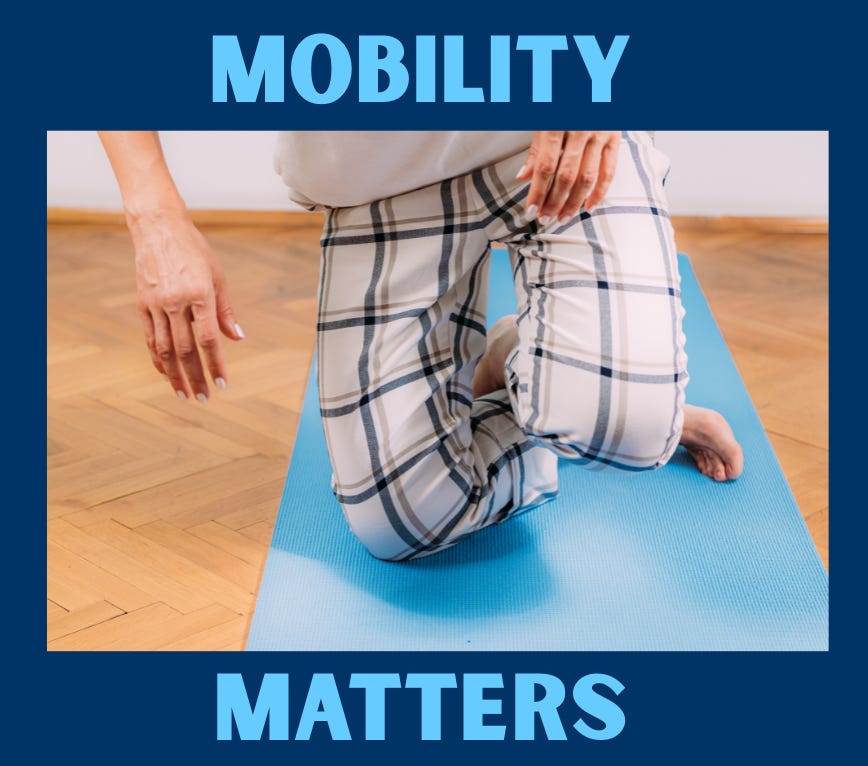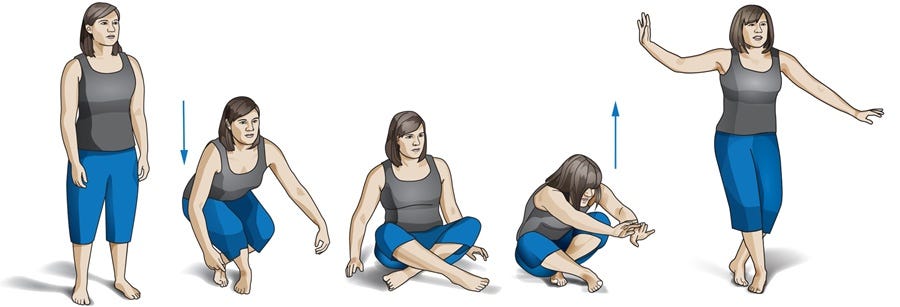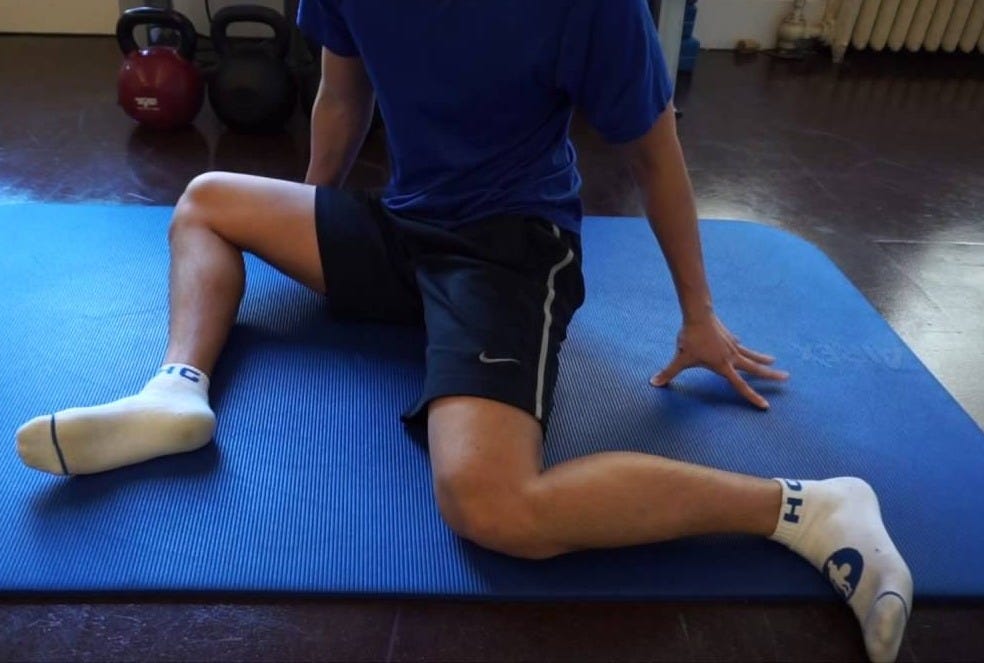You’re in good shape. You get to the gym, clock your steps, and do some stretching or yoga. So why do you still feel stiff when you stand up after sitting? Or maybe you’ve started avoiding certain movements or activities that seem hard or awkward. You’re doing everything right, so what’s wrong?
There’s a big piece of the wellness puzzle that often gets overlooked. That missing piece? Mobility. You may be surprised to learn that achieving good mobility doesn’t require strength training, cardio, or even stretching. None of those activities replace practices that engage the muscles, tissues, bones, and joints through simple yet vital movements. Mobility movements do, and they’re the key to maintaining your vitality and independence.
What Mobility Really Is (and What It Isn’t)
Mobility is the ability to move your joints through their full range of motion with control, stability, and strength. It’s what lets you:
Squat down to pick something up (and get back up).
Reach overhead without straining your neck or back.
Twist to look behind you while driving.
Transition easily between sitting, standing, and getting down to the floor.
Mobility movement engages your body’s entire infrastructure. It’s what allows you to move freely through your life and get up and down from the floor without struggling.
Mobility also creates a ripple effect. When you enhance your capacity for free and easy movement, you positively affect all your bodily systems—digestive, circulatory, immune, and lymphatic. Simply put, mobility primes your body for life.
Mobility isn’t the same thing as flexibility. It’s not strength or cardio, either. While each of those is important, mobility training is its own discipline.
Even if you stretch and have decent flexibility, stretching only partially improves mobility. It works through passive tension and targets the muscles. On the other hand, mobility movements work the connective tissue, joints, and nervous system. They require active control and go beyond stretching to give your movements power, precision, and ease.
Why Mobility Matters More Than Ever
Mobility is about quality of life—not just fitness. It’s foundational to how you move through your day. When it starts to slip, we feel it in subtle ways:
That hesitation before bending down.
A stiffness when standing after sitting.
Awkwardness getting in and out of the car.
Left unaddressed, these small changes can lead to bigger problems like pain, balance issues, and loss of independence. The good news? Even if your mobility has declined, it can be improved at any age.
Aging Isn’t the Enemy—Inactivity Is
We all move in some way every day. But most of us don’t move as much or in the ways we need to. We’ve been led to believe that 150 minutes of cardio each week is enough to avoid being sedentary. While I fully support reaching that goal, it doesn’t make up for sitting the majority of the time.
Aging brings natural changes:
Muscle loss (sarcopenia), which reduces strength and control.
Joint stiffness and cartilage wear, which limits range of motion.
Fascial tension from lack of movement, which restricts fluid motion.
Neuromuscular decline, which affects balance and coordination.
However, research shows many of these changes are preventable, and even reversible, with consistent and intentional movement.
The real issue? We sit too much. Whether it’s at a desk, in a car, or on the couch, our modern lifestyle leads to imbalanced movement patterns. These patterns shorten some muscles and weaken others. Over time, our bodies adapt in ways that work against us.
A Sneak Peek: The Sit-and-Rise Test
Here’s one quick way to check your mobility:
Can you sit on the floor and stand back up without using your hands?
It’s not just a party trick. Studies have linked this simple test to overall longevity and functional independence.
How to perform the test:
Stand next to a wall or a sturdy piece of furniture if you think you’ll need help.
Cross one foot in front of the other and sit down on the floor (gently and with control) without holding onto anything (unless you feel unsteady).
From the same cross-legged position, rise up off the floor without using a support, if possible.
Lean forward with your hands outstretched in front of you to keep your balance.
Start with a score of 10 and subtract one point for each of the following:
Bracing yourself with a hand on the floor or other solid surface.
Placing a hand on the ground.
Touching your knee to the floor.
Supporting yourself on the side of your legs.
Losing your balance.
This is your starting number. Use it to track your progress. Most people don’t score a 10 right away; but with practice, improvement is very achievable.
What your score means:
10 points: Excellent mobility and control. Maintain your current practice.
7-9 points: You’re close. With consistent practice, you’ll hit 10.
3-6 points: You’re trending in the right direction. Prioritize hip mobility.
0-2 points: Floor transitions are difficult, but you can get better. It takes leg and core strength, coordination, and hip range of motion. You can build these skills through consistent mobility work.
Floor Time is Functional Fitness
A few months ago I realized that I was avoiding getting down on the floor. It felt awkward and inconvenient. But the more I avoided it, the harder it became.
Now I include floor sitting in my daily routine. I use various positions and lean against a wall when needed. As my strength and mobility improve, I use less support.
Here are my go-to positions:
Cross-legged: Sit with your bum on the ground. Bend both legs and cross one in front of the other. Keep your back straight or lean forward slightly. Switch legs halfway through.
Legs Straight: Sit with your legs extended in front. Keep your back tall, or lean slightly forward.
One Leg Bent: Sit with one leg extended and the other bent. Place the foot of the bent leg flat on the floor and clasp your hands around your shin. Switch sides after a few minutes.
90/90 Sitting: Sit with one leg in front of you at a 90-degree angle from your hip. The other leg also bends to 90 degrees, with the foot behind you. Shift positions after a few minutes.
I still use one hand to help myself get up and down, but I’m improving. It’s a small daily investment with big returns.
Easy Ways to Start Moving Better Today
You don’t need fancy equipment or hours of free time to improve mobility. Start where you are. Try this:
1. Morning Mobilizations
Spend 5 minutes doing gentle mobility movements like neck rolls, hip circles, or cat-cow transitions to “wake up” your joints and get your body moving intentionally.
2. Movement Snacks
Every hour, take 2 minutes to change positions, perform a few shoulder blade glides, ankle pumps, or thoracic rotations. These small mobilizations keep stiffness at bay and reset your posture.
3. Floor Time
Get down on the floor at least twice a day. Just the act of getting down and back up improves core strength, coordination, and joint control. Start with assistance if needed. It still counts.
4. Move While You Wait
Do controlled leg swings, arm circles, or deep breathing with rib cage expansion while waiting for coffee to brew or during TV commercials. These are small but powerful ways to add mobility movements into your day.
5. Evening Wind-Down
Instead of passive stretching, try gentle mobilizations like pelvic tilts, spinal twists, or controlled knee hugs to release tension and reset your nervous system before bed.
What’s Next?
At the end of June, I’m launching a 28-day Mobility Reset. It’s a gentle, progressive program designed to restore the way you move. You’ll learn how to integrate smart mobility into your daily life with short, manageable sessions that meet you where you are.
Whether your goal is to feel more fluid in the morning, loosen up stiff hips, or master a hands-free floor transition, this program can help you move better now and for years to come.
Stay tuned. More details are coming soon.
You Can Do It
Mobility isn’t optional. It’s essential. The best part? You don’t need to overhaul your life to improve it.
Start small. Stay consistent. You’ll feel the difference in how you move, how you sit, and how you live.
What’s your biggest mobility challenge? Leave a comment and let me know. I’d love to hear from you!










Happy Friday! Once again you have take, what for many, is a complicated idea and made it simple. After 35 years in practice I found one of the more meaningful “tests” may have been watching a patient enter/exit a vehicle or simply move from sit to stand from a waiting room chair. So many times these movements were more telling than an MRI or CT. Thanks for not over medicalizing an important line of thought.
Best, SBS
This is a great article, Daria. I do yoga daily as well as walking several times a week and strength training twice a week. And I’ve noticed my stiffness just keeps getting worse. I hadn’t thought of mobility as its own concern over and above exercise. I’m looking forward to learning more. Thank you.